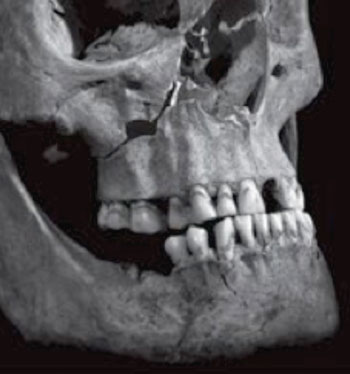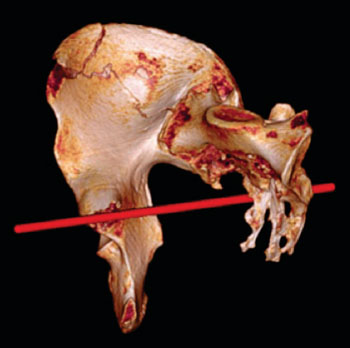Whole Body, Micro-CT Scan Techniques Identify Probable Cause of English King’s Death
|
By MedImaging International staff writers Posted on 06 Oct 2014 |

Image: Inferior aspect of the skull; digital photograph with a micro-CT inset of the penetrating injury, with associated inner table injury (arrow). Scale in mm; a = large sharp-force trauma with bone fragment that could be refitted for imaging; b = penetrating injury (Photo courtesy of the Lancet).

Image: Facial skeleton digital photograph; arrow shows the penetrating injury to the maxilla (Photo courtesy of the Lancet).

Image: Reconstructed right hemi-pelvis and sacrum post-mortem CT using Osirix. Red line shows estimated direction of sharp-force trauma (Photo courtesy of the Lancet).
A team of forensic imaging investigators used whole body computed tomography (CT) scans and micro-CT imaging of injured bones to analyze trauma to the English King Richard III’s 500-year-old skeleton carefully, and to determine which of the king’s wounds might have been fatal. Richard was the last English monarch to perish in battle.
The remains of the king were found under a car park in Leicester, UK by archaeologists. The forensic imaging researchers, working with the forensic pathology unit and the department of Engineering at the University of Leicester (UK), used whole-body CT scans and micro-CT imaging of injured bones to analyze trauma to the 500-year-old skeleton carefully, and to determine which of the King’s wounds might have proved lethal. They also studied tool marks on bone to identify the medieval weapons potentially responsible for his injuries.
The findings, published September 17, 2014, in the Lancet, revealed that Richard’s skeleton bore 11 wounds at or close to the time of his death—nine of them to the skull, distinctly sustained in battle and suggesting he had removed or lost his helmet, and two to the postcranial skeleton.
Sarah Hainsworth, study author and professor of materials engineering at the University of Leicester, explained, “Richard’s injuries represent a sustained attack or an attack by several assailants with weapons from the later medieval period. The wounds to the skull suggest that he was not wearing a helmet, and the absence of defensive wounds on his arms and hands indicate that he was otherwise still armored at the time of his death.”
The investigators, led by Dr. Jo Appleby, from the University of Leicester School of Archaeology and Ancient History, deduced that the postcranial injuries, including the possibly fatal one to the pelvis, might have been inflicted after Richard’s death, on the basis that had he been alive he would have been wearing a specific type of armor worn in the late 15th century that would have prevented such wounds.
According to Prof. Guy Rutty, study coauthor, from the East Midlands pathology unit at the University of Leicester, “The most likely injuries to have caused the King's death are the two to the inferior aspect of the skull—a large sharp force trauma possibly from a sword or staff weapon, such as a halberd or bill, and a penetrating injury from the tip of an edged weapon. The Richard’s head injuries are consistent with some near-contemporary accounts of the battle, which suggest that Richard abandoned his horse after it became stuck in a mire and was killed while fighting his enemies.”
Commenting on the research, Dr. Heather Bonney from the Natural History Museum (London, UK), said, “Appleby and colleagues provide a compelling account, giving tantalizing glimpses into the validity of the historic accounts of his death, which were heavily edited by the Tudors in the following 200 years. Wherever his remains are again laid to rest, I am sure that Richard III will continue to divide opinion fiercely for centuries to come.”
Related Links:
University of Leicester
The remains of the king were found under a car park in Leicester, UK by archaeologists. The forensic imaging researchers, working with the forensic pathology unit and the department of Engineering at the University of Leicester (UK), used whole-body CT scans and micro-CT imaging of injured bones to analyze trauma to the 500-year-old skeleton carefully, and to determine which of the King’s wounds might have proved lethal. They also studied tool marks on bone to identify the medieval weapons potentially responsible for his injuries.
The findings, published September 17, 2014, in the Lancet, revealed that Richard’s skeleton bore 11 wounds at or close to the time of his death—nine of them to the skull, distinctly sustained in battle and suggesting he had removed or lost his helmet, and two to the postcranial skeleton.
Sarah Hainsworth, study author and professor of materials engineering at the University of Leicester, explained, “Richard’s injuries represent a sustained attack or an attack by several assailants with weapons from the later medieval period. The wounds to the skull suggest that he was not wearing a helmet, and the absence of defensive wounds on his arms and hands indicate that he was otherwise still armored at the time of his death.”
The investigators, led by Dr. Jo Appleby, from the University of Leicester School of Archaeology and Ancient History, deduced that the postcranial injuries, including the possibly fatal one to the pelvis, might have been inflicted after Richard’s death, on the basis that had he been alive he would have been wearing a specific type of armor worn in the late 15th century that would have prevented such wounds.
According to Prof. Guy Rutty, study coauthor, from the East Midlands pathology unit at the University of Leicester, “The most likely injuries to have caused the King's death are the two to the inferior aspect of the skull—a large sharp force trauma possibly from a sword or staff weapon, such as a halberd or bill, and a penetrating injury from the tip of an edged weapon. The Richard’s head injuries are consistent with some near-contemporary accounts of the battle, which suggest that Richard abandoned his horse after it became stuck in a mire and was killed while fighting his enemies.”
Commenting on the research, Dr. Heather Bonney from the Natural History Museum (London, UK), said, “Appleby and colleagues provide a compelling account, giving tantalizing glimpses into the validity of the historic accounts of his death, which were heavily edited by the Tudors in the following 200 years. Wherever his remains are again laid to rest, I am sure that Richard III will continue to divide opinion fiercely for centuries to come.”
Related Links:
University of Leicester
Latest Radiography News
- Novel Breast Imaging System Proves As Effective As Mammography
- AI Assistance Improves Breast-Cancer Screening by Reducing False Positives
- AI Could Boost Clinical Adoption of Chest DDR
- 3D Mammography Almost Halves Breast Cancer Incidence between Two Screening Tests
- AI Model Predicts 5-Year Breast Cancer Risk from Mammograms
- Deep Learning Framework Detects Fractures in X-Ray Images With 99% Accuracy
- Direct AI-Based Medical X-Ray Imaging System a Paradigm-Shift from Conventional DR and CT
- Chest X-Ray AI Solution Automatically Identifies, Categorizes and Highlights Suspicious Areas
- AI Diagnoses Wrist Fractures As Well As Radiologists
- Annual Mammography Beginning At 40 Cuts Breast Cancer Mortality By 42%
- 3D Human GPS Powered By Light Paves Way for Radiation-Free Minimally-Invasive Surgery
- Novel AI Technology to Revolutionize Cancer Detection in Dense Breasts
- AI Solution Provides Radiologists with 'Second Pair' Of Eyes to Detect Breast Cancers
- AI Helps General Radiologists Achieve Specialist-Level Performance in Interpreting Mammograms
- Novel Imaging Technique Could Transform Breast Cancer Detection
- Computer Program Combines AI and Heat-Imaging Technology for Early Breast Cancer Detection
Channels
MRI
view channel
World's First Whole-Body Ultra-High Field MRI Officially Comes To Market
The world's first whole-body ultra-high field (UHF) MRI has officially come to market, marking a remarkable advancement in diagnostic radiology. United Imaging (Shanghai, China) has secured clearance from the U.... Read more
World's First Sensor Detects Errors in MRI Scans Using Laser Light and Gas
MRI scanners are daily tools for doctors and healthcare professionals, providing unparalleled 3D imaging of the brain, vital organs, and soft tissues, far surpassing other imaging technologies in quality.... Read more
Diamond Dust Could Offer New Contrast Agent Option for Future MRI Scans
Gadolinium, a heavy metal used for over three decades as a contrast agent in medical imaging, enhances the clarity of MRI scans by highlighting affected areas. Despite its utility, gadolinium not only... Read more.jpg)
Combining MRI with PSA Testing Improves Clinical Outcomes for Prostate Cancer Patients
Prostate cancer is a leading health concern globally, consistently being one of the most common types of cancer among men and a major cause of cancer-related deaths. In the United States, it is the most... Read moreUltrasound
view channel
First AI-Powered POC Ultrasound Diagnostic Solution Helps Prioritize Cases Based On Severity
Ultrasound scans are essential for identifying and diagnosing various medical conditions, but often, patients must wait weeks or months for results due to a shortage of qualified medical professionals... Read more
Largest Model Trained On Echocardiography Images Assesses Heart Structure and Function
Foundation models represent an exciting frontier in generative artificial intelligence (AI), yet many lack the specialized medical data needed to make them applicable in healthcare settings.... Read more.jpg)
Groundbreaking Technology Enables Precise, Automatic Measurement of Peripheral Blood Vessels
The current standard of care of using angiographic information is often inadequate for accurately assessing vessel size in the estimated 20 million people in the U.S. who suffer from peripheral vascular disease.... Read moreNuclear Medicine
view channel
New Imaging Technique Monitors Inflammation Disorders without Radiation Exposure
Imaging inflammation using traditional radiological techniques presents significant challenges, including radiation exposure, poor image quality, high costs, and invasive procedures. Now, new contrast... Read more
New SPECT/CT Technique Could Change Imaging Practices and Increase Patient Access
The development of lead-212 (212Pb)-PSMA–based targeted alpha therapy (TAT) is garnering significant interest in treating patients with metastatic castration-resistant prostate cancer. The imaging of 212Pb,... Read moreNew Radiotheranostic System Detects and Treats Ovarian Cancer Noninvasively
Ovarian cancer is the most lethal gynecological cancer, with less than a 30% five-year survival rate for those diagnosed in late stages. Despite surgery and platinum-based chemotherapy being the standard... Read more
AI System Automatically and Reliably Detects Cardiac Amyloidosis Using Scintigraphy Imaging
Cardiac amyloidosis, a condition characterized by the buildup of abnormal protein deposits (amyloids) in the heart muscle, severely affects heart function and can lead to heart failure or death without... Read moreGeneral/Advanced Imaging
view channel
Radiation Therapy Computed Tomography Solution Boosts Imaging Accuracy
One of the most significant challenges in oncology care is disease complexity in terms of the variety of cancer types and the individualized presentation of each patient. This complexity necessitates a... Read more
PET Scans Reveal Hidden Inflammation in Multiple Sclerosis Patients
A key challenge for clinicians treating patients with multiple sclerosis (MS) is that after a certain amount of time, they continue to worsen even though their MRIs show no change. A new study has now... Read moreImaging IT
view channel
New Google Cloud Medical Imaging Suite Makes Imaging Healthcare Data More Accessible
Medical imaging is a critical tool used to diagnose patients, and there are billions of medical images scanned globally each year. Imaging data accounts for about 90% of all healthcare data1 and, until... Read more
Global AI in Medical Diagnostics Market to Be Driven by Demand for Image Recognition in Radiology
The global artificial intelligence (AI) in medical diagnostics market is expanding with early disease detection being one of its key applications and image recognition becoming a compelling consumer proposition... Read moreIndustry News
view channel
Hologic Acquires UK-Based Breast Surgical Guidance Company Endomagnetics Ltd.
Hologic, Inc. (Marlborough, MA, USA) has entered into a definitive agreement to acquire Endomagnetics Ltd. (Cambridge, UK), a privately held developer of breast cancer surgery technologies, for approximately... Read more
Bayer and Google Partner on New AI Product for Radiologists
Medical imaging data comprises around 90% of all healthcare data, and it is a highly complex and rich clinical data modality and serves as a vital tool for diagnosing patients. Each year, billions of medical... Read more

















